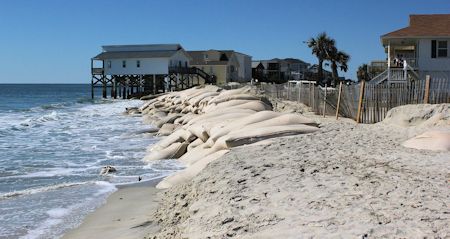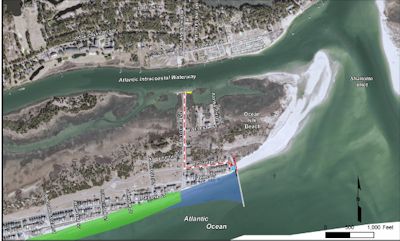
OCEAN ISLE BEACH — Two decades of chronic erosion have taken its toll on this beach town’s east end where beachfront properties have been consumed by the ocean and state roads repeatedly repaired.
Town leaders are now banking on the construction of a 750-foot terminal groin to fend off further loss of sand, according to a recently released environmental study by the Army Corps of Engineers.
Supporter Spotlight
“The town of Ocean Isle Beach has been planning for this for a long time, long before the law was changed,” Mayor Debbie Smith said. “We knew we had to do something at some point. None of the stopgap measures that we’ve performed have been effective.”
The stretch of beach at the eastern end of the barrier island was left out of the town’s 2001 federal beach nourishment project because of a predicted high rate of sand loss on that section of beach. About 2,000 feet of the eastern tip of the roughly 5.5-mile-long island has remained highly susceptible to erosion.
A sandbag revetment and dunes have been built, public accesses replaced and water and sewer lines relocated, costing the town more than $3.5 million and the N.C. Department of Transportation about $1 million over the past decade, according to the Corps’ draft Environmental Impact Statement that was released Jan. 23.
“Right now we’ve got a 1,500-foot wall of sandbags down there, which nobody likes,” Smith said. “We believe our modeling from our engineers is showing us that not only will this terminal groin protect where we have sandbags in front of our properties, it will probably extend the life of our federal beach re-nourishment project from a three-year cycle to a five or six-year cycle.”
The town considered three lengths of terminal groins, including a 500-foot wall and a 250-foot wall.
Supporter Spotlight
Predictions that a 750-foot terminal groin would stabilize the shoreline and save money over the next 30 years by extending the time between re-nourishment projects prompted the town to choose that particular length of wall.

The terminal groin, which would include a 300-foot anchorage section upland, would be designed to control rapid shoreline changes just west of Shallotte Inlet.
The proposed project would include beach fill from the inlet, which separates Ocean Isle Beach and Holden Beach and is where the town gets sand for its re-nourishment project. The sand source would be tapped every five years to nourish a 3,214-foot section of shoreline directly west of the terminal groin.
“It will be built where it is leaky and porous,” Smith said. “Where it’s located we’re not going to rob anyone of sand.”
The proposed terminal groin was “found to not have any significant impact on the shoreline or periodic nourishment requirements of the federal project west,” according to the draft document.
The study states that there are nearly 240 parcels, 45 homes and more than 1,800 feet of roads and utilities vulnerable to damage or loss from erosion over the next 30 years.
Smith said property owners are “on board” with the proposed project.
“Not only the ones who have been directly affected, but the other property owners understand that the publicity of an eroding beach is not good for anyone on the island,” she said.
A terminal groin may not be good for the island either, according to the N.C. Coastal Federation, which is opposed to hardened erosion-control structures.
“We are still in the process of reviewing the draft EIS and will be developing detailed comments for the record,” Ana Zivanovic-Nenadovic, program and policy analyst with the federation, said in an email. “From the first look we can say that this structure will only protect a few homes at a very high cost to the entire community.”
An analysis she conducted for the federation in 2012 looked at land ownership and tax records of property at the eastern end of the island. It revealed that 61 percent of the 631 properties in the hazard area near the inlet at the time was held by three companies owned or managed by the family of Odell Williamson, a longtime civic leader and one of the original developers of Ocean Isle Beach.

More than 300 of those properties are currently not suitable for building and each has a total taxable value of $100, according to the analysis.
The projected cost of building a terminal groin at the inlet and subsequent re-nourishment over a 30-year period is about $46.6 million. The town would pay for about half of the federal storm damage reduction project costs associated with that tab and the government would pick up the other half.
“This structure will put the town on the hook for potential claims of property losses for lands that are currently undeveloped and which can’t be developed at the eastern end of the island,” Zivanovic-Nenadovic stated.
She emphasized the state law requirement that local voters approve funding to build a terminal groin.
Registered voters on Bald Head Island last May approved an $18 million bond referendum to fund that town’s terminal groin project, the first in North Carolina to receive a state permit for construction since the General Assembly in 2011 passed a law allowing up to four such structures along the coast.
Construction of the 1,900-foot terminal groin at Bald Head is expected to begin in the coming months. The groin will be built in two phases, the first of which will be 1,300-foot structure. An additional 500 feet of wall will be added following a two-year monitoring period.
Figure Eight Island in New Hanover County continues to await the release of a supplement to the original draft EIS of the private island’s proposed terminal groin project.
“It’s still being developed and no time has been given as to when it will be released,” said Mickey Sugg, project manager with the Corps’ Wilmington office.
Holden Beach is also pursuing a terminal groin project, though it is unclear where that town is in the process.
The release of the draft EIS of Ocean Isle Beach’s proposed project will be followed by a public comment period and eventual release of a final environmental statement.
“We hope if we can keep it on track and, given all the comment periods and reasonable anticipation from changes made, we’re hoping maybe we can apply for a permit this fall and have construction over the 2015-2016 winter,” Smith said. “That’s a timetable we should be able to meet.”







